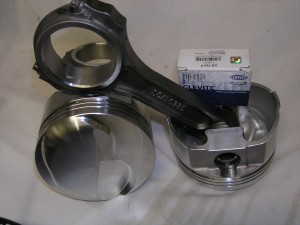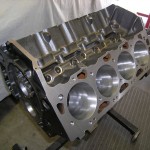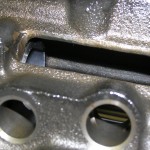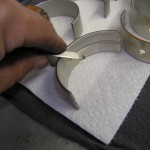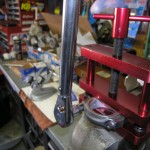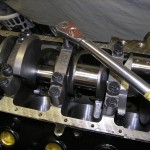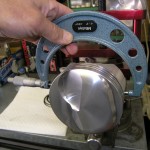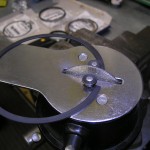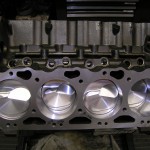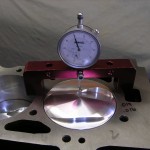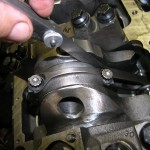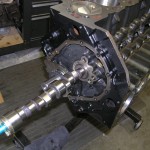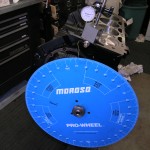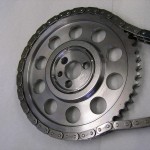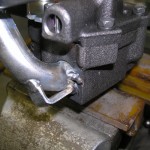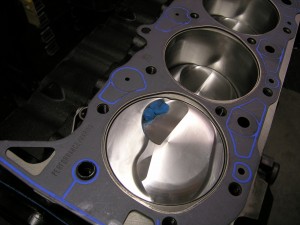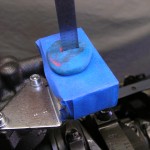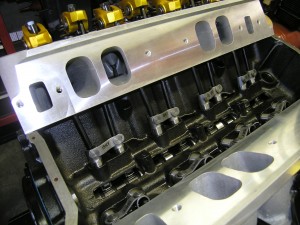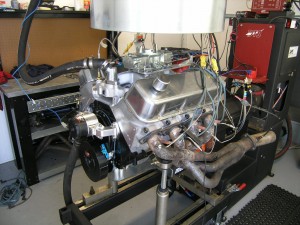468 Big Block Chevy – 624 horsepower – 590 lb-ft torque
A Gen V four bolt main 7.4L block and all the parts that will go into 468 build
Forged SRP Pistons, Scat 6.385″ connecting rods with ARP bolts
An Iskenderian hydraulic roller cam, Cloyes double roller timing chain, a pair of Profiler 290cc aluminum cylinder heads
The beginning
A Gen V – 4 bolt main 7.4L (454) block hot tanked, magged for cracks, line honed, bored .060 over, decked to zero deck height
Removed the extra casting flash and cleaned all threads with a thread chaser, installed new dura bond cam bearings, the top and bottom of the cylinders were chamfered to improve ring installation reduce scuffing of the piston skirts
Checking bottom end clearances
I cleaned and deburring verifying the quality of the bearing finish and ensure they are burr free before installation
I torqued the ARP main cap bolts to 100 lb-ft verify the crank main journals (2.748″) then checked to journals (2.751″) to get our (.003″) bearing clearance The rod journals were (2.194″), torqued the ARP rod bolts to 63 ft-lb, verify the connecting rod bearings (2.219″) to get our (.0025″) bearing clearance Note: The first set of rod bearings yielded a (.003″) clearance after installing a slightly under sized bearing we got our (.0025″) clearance
checked the crankshaft end play with a few taps of the rubber mallet it was (.006″)
Bottom end installed
The forged SRP piston diameter (4.277) the cylinder diameter was (4.281″) gave use (.004″) piston to cylinder wall clearance
To insure proper cylinder sealing and minimize oil consumption the ring end gap needs to be set. I used a set of Total Seal file fit rings which are (.005″) larger than the bore diameter. This allows the builder to cut the rings to the exact size for each cylinder. The ring manufacturer calls for a (.019″) top ring and (.016″) second ring end gap. Each ring is hand filed and fitted to its specific cylinder.
The pistons are installed and I check the deck height (.000″)
After the pistons and rods are torqued down the rod side clearance is checked (.023″ – .024″)
Camshaft and oiling system installed
I installed an Iskenderian hydraulic roller cam 396282/293 installed it +3 degrees advanced
I installed a timing chain with a Torrington bearing the Gen V Big Block timing chain covers are hard to come so I modified the existing cover but I welded on an additional plate to stiffen it up, the camshaft end play is (.005″)
I installed a 7 Qt. Moroso pi; pan with an oil scraper
The oil pump pickup to oil pan clearance was set at (3/8″) I tack welded the pickup to the pump
Heads, valve train, and induction system installed
The rocker arms, lifters, and push rods were installed, piston to valve clearance on the intake (.220″) and exhaust (.200″)
The valve train geometry and push rod length was verified the push rods lengths ended up at (7.650″ and 8.650″)
Installed an Edelbrock Performer RPM Air-Gap intake manifold, Speed Demon 850 CFM double pumper carb and MSD billet distributor

Dyno Testing – Judgement Day
I ran the 468 on a DTS Powermark dyno at Saddleback Community College in Mission Viejo Calif.I did a 20 minute break-in verify timing and set the air/fuel ratio and after a quick cold down period we let the 468 go pulling it to 6500 RPM
624 horsepower – 590 lb-ft torque on 91 Octane pump gas
Click here to view the JMac Performance built 468 on the dyno
This engine is a great example of what can be done when the proper parts are used and the proper engine building techniques are implemented
Contact JMMcKindley990@gmail.com if you’d like more details on this engine build

